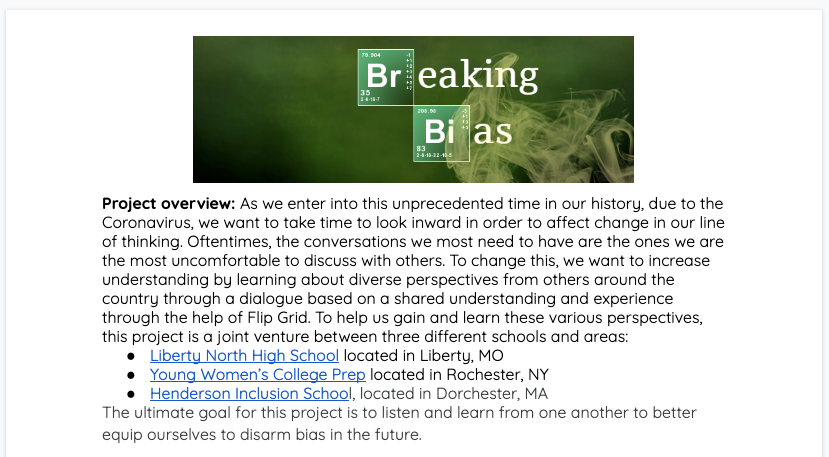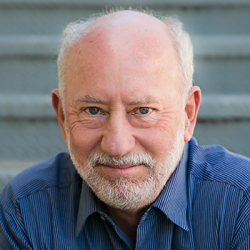Originally published Jun 12, 2020 – updated Apr 16, 2021.

If you're looking for projects to foster conversations about race and racism with your students, we hear you.
Over the past year, we've heard from many teachers who are exploring racial equity through PBL. There are driving questions for projects about systemic racism, the killing of George Floyd, Ahmaud Arbery, and so many other Black people, on the protests, on policing.
Here are a few projects from our project library that you might use to focus on any of these topics...
- Make a Difference — How can we take action to make a change in our community?
- Lifting Our Voices — How can we use our voices to effect change?
- Broken Laws — How can we change the law to make our society better for everyone?
- Waiting on the World to Change — How can we make change happen in our community?
And here's a deep dive into one project—the "Breaking Bias" project—that was developed in Spring 2020.
The project was designed and supported by Alicia Peletz, an educational consultant who is also a member of PBLWorks National Faculty.
In April 2020, she told us about this project for remote learning that was being implemented by teachers she works with.
It perfectly suits this moment and has inspired many projects over the past year.
The “Breaking Bias” project was conducted at three different high schools, with the goal “to listen and learn from one another to better equip ourselves to disarm bias in the future.”
In addition to racial bias, I can imagine many applications for the basic idea: connect high school students from varying communities to engage in dialogue.
Here’s how it's described in the project overview: “As we enter into this unprecedented time in our history, due to the Coronavirus, we want to take time to look inward in order to affect change in our line of thinking. Oftentimes, the conversations we most need to have are the ones we are the most uncomfortable to discuss with others. To change this, we want to increase understanding by learning about diverse perspectives from others around the country through a dialogue based on a shared understanding and experience through the help of Flipgrid.”
The project was a joint venture between Liberty North High School in Liberty, Missouri; Young Women’s College Prep in Rochester, New York; and Henderson Inclusion School in Dorchester, Massachusetts.
The project took place across all three schools from April 6 to May 7, 2020.
Each school did some project activities on their own, and the shared part was especially powerful.
Students watched and discussed videos and read about racism in the US. In addition to Flipgrid, they used Padlet to share ideas and writing.
You can find more details about the project on this Google Doc.
A few weeks after the project, the killing of George Floyd sparked protests and a national dialogue around race.
At that time, the participating teachers reconnected and shared some of their reflections on the moment.
“Now, more than ever it is important to have the difficult conversations with young people," said Rachel Harcrow, teacher at Young Women’s College Prep in New York. "We as Americans need to seek to understand and move forward toward social justice."
In Missouri at Liberty North High School, the learning and innovation coach Tara Harvey said: “This is such a crucial time for dialogue in our country. I hope that our students are feeling more equipped to participate in conversations, ask questions, and be reflective about what they are consuming. If there was a single goal in humanities this year, I believe it was to make our students aware that the complexity of history and our current reality is necessary to unpack and it is our job to join the conversation."
Another Liberty North teacher, Josh Baldwin said: “My hope for our students is that they are able to draw on the information and experiences that this project helped facilitate in order to go out and be an advocate for the marginalized in communities around the country. Humanities (and this project, specifically) was created for the purpose of uniting history with the present and helping students understand their role in learning from the former to impact the latter.”
And their colleague, also a teacher at Liberty North, Elizabeth Rudell shared: “My hope is that students are able to use what they've learned throughout this year in Humanities (but especially this project!) on what it means to be a humanitarian, someone who fights for those voices that have been oppressed and silenced for too long. I hope that what they've started to recognize is something they can talk about - with their friends, family, and people they've come in contact with throughout their lives." –
In Massachusetts at Henderson Inclusion School, teacher Sam Texeira said: “For my students, the news of the murders of George Floyd and Breonna Taylor was not a particular shock as most have been socialized in a world in which vulnerability and loss of Black and Brown bodies are all too common. That said, it is my hope that the modern contexts of the moment, combined with a sense of academic inspiration to be engaged through PBL as opposed to more traditional forms of pedagogy, will inspire my students' sociopolitical consciousness to understand that the violence, daily racism, and marginalization aren't "normal" and that they have a responsibility to act in community with others for progress.”
Students made similarly powerful comments after it was over in their Padlet reflections, too. These are impactful lessons that will inspire many of them to take action for an anti-racist future in this country.
Tune in to our podcast to hear about it firsthand from teachers.
There's an episode on our podcast The Project that features the "Breaking Bias" project. If you want to hear directly from the teachers, then this is for you. Check it out, and let us know what you think.
How are you addressing racism in projects with your students? Let us know by joining the conversation with @PBLWorks on Twitter. You can find more blog posts about PBL & Equity.


